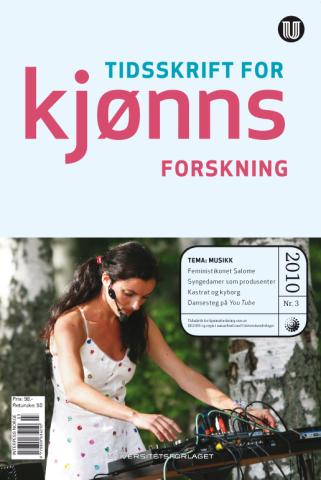Music

Articles
Hedda Høgåsen-Hallesby:
Salome’s situation
Bodies on stage and staged bodies in two scenes from Richard Strauss’ Salome (1905) are discussed in this article. This opera has served a double duty in feminist interpretations. On the one hand, Salome stands as the representation of the Absolute Other, musically, culturally and historically. On the other hand, she has been interpreted as a heroine who subverts established, patriarchal structures through her performance. The aim of my discussion is to mediate between these two positions with help from Simone de Beauvoir’s concept of situation and through tracing the array of authorial voices at work in opera. By looking at different productions of Salome I find that this opera demonstrates a "restricted freedom" or a dependent process of retelling, which lead me to the conclusion that opera production is a phenomenon being simultaneously limited and open, conservative and radical, historical and present. This oscillation is what I claim to be Salome’s most important contribution to feminist opera scholarship.
Key Words: opera, feminist interpretations, dramaturgy, representations, embodiment, situation, Simone de Beauvoir, Oscar Wilde, Richard Strauss
Anne H. Lorentzen:
I used to be a "songbird". Resignification and change in popular music production1
The article uses Judith Butler’s concept of resignification to study change in popular music production. Seen from the outside, music production appears rather static and heteronormal in terms of who does what in the recording studio. The division of labour, in fact, seems almost law-like, with him in charge of the mixing console (as the producer), and she in charge of the microphone (as the "songbird"). Resignification allows the researcher to analyse change in terms of breaks and ruptures in this somewhat law-like situation, but also how breaks come about. It shows that resignification occurs or manifests in many guises, ranging from speech-acts to bodily movements/postures and musical gestures/events. Resignification, however, should not be studied as a singular event, but as "[mis-] citational chains lived and believed by the level of the body" (Butler 1997:155), and as stylised and/or ritualised misappropriations of norms. Thus, resignification might be seen as constituting realities in much the same way as the conventional processes of signification do. The researcher might also participate in the resignification process, by theoretical interventions, but also by paying attention to, and «re-repeating» those very same misappropriations and miscitations in speech and writing.
Keywords: gender, popular music, music production, "songbird", producer, music technologies, performativity, rituals, rites of passage, resignifiation
1The term "songbird" is here used as a translation of the Norwegian term "syngedame", literally "singing lady". "Syngedame" is an ambiguous term that may have both negative and positive connotations. It may refer to the simple fact of a "a woman who sings" (for money), but the term is perhaps more often used in degrading ways, such as to indicate a lower status in the hierarchy of musical positions, in terms of musical capability, authenticiy and credibility, but also in terms of the production process as such. "Songbird" have been suggested as a possible translation of "syngedame", and I use it here in the await of a better or more accurate suggestion.
Erik Steinskog:
Voices of gendered ambiguity. The castrato and the cyborg
Voices are commonly heard as gendered, and most often within a classical gender binarism. Some voices, however, challenge this, and come across as ambivalent. This article discusses two such voices: those of the castrato and the cyborg respectively. Rather than trying to trace a timeline from the castrato in the 18th century to the cyborg today (or in a near future), the article uses these two figures as points of comparison. A queer reading of these ambivalent voices highlights the intersection of voice and technology (in a broad sense of the word) as basis for the construction of vocal performances.
Key words: voice, castrato, cyborg, opera, film
Ann Werner:
Dance steps. Music, gender and ethnicity – with bodies on YouTube
YouTube is a platform for participatory media culture where millions of people from all over the world upload videos for others to view and comment on. While some of these videos mirror overt commercial interests others are part of a "do it yourself" (DIY) culture in which people conduct practical jokes, play music or dance. Online user culture has increased the number of people that produce their own media and broadcast it to others and it is now common in countries like Sweden, Australia and the US to interact with others through DIY online media. One of many phenomena on YouTube is people – mainly girls – that film themselves imitating the dances of globally successful female artists like Britney Spears, Beyoncé or Lady Gaga. This identity play, which often takes place in a home environment, takes on certain meanings online. The dress-up play of imitating and dancing is mediated in a special way on YouTube, and in the process of mediation bodies interact with media technology, music, dance styles and other users. This article investigates the intersections of gender, ethnicity, race and new media created in clips where people imitate the dances of Beyoncé.
Keywords: gender, ethnicity, race, girls, dance, music, online culture, Beyoncé